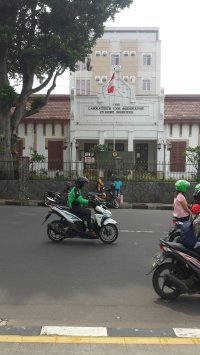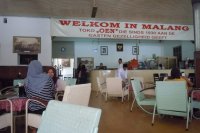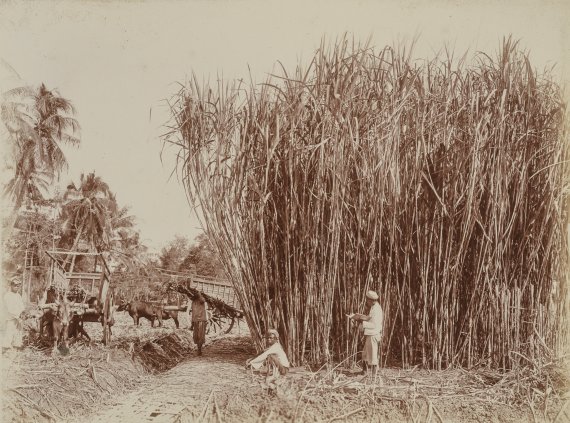A sugar plantation on Java in the early 20th century. ©WUR Library
©Photo’s article: Albert Sikkema

A colonial laboratory in Bogor
In the middle of the Javanese city of Bogor – one million residents – lies a green lung of 87 hectares. As hair-raising traffic passes on the ring road around these botanical gardens, groups of Indonesian schoolchildren are having biology lessons in a peaceful oasis. Bogor Botanical Gardens house 14,000 tropical plants and trees, from giants of the forest to many varieties of palm tree. The garden also boasts an old laboratory and a zoological museum that date back to the time when Bogor was called Buitenzorg and was part of the Dutch East Indies. The garden was established in 1817 by Dutchman Reinwaldt, who wanted to create a place that would ‘satisfy people’s curiosity.’
A century ago, these botanical gardens were the hub of agricultural research in Indonesia. I am looking for traces of Wageningen University, but I can’t find any. What I do find is the Treub Laboratory, the head office of the Forest Research and Development Agency, and the Laboratory for Agro-ecology and Soil Research, but these were not part of Wageningen Agricultural College. In the early twentieth century,it was botanists, agronomists, chemists and soil scientists from Leiden, Utrecht and Amsterdam who called the tune in Bogor.
Elsewhere on the campus, Nanik Purwanti points out a sign mentioning Wageningen.
Sign
Next door to the Botanical Gardens is the original compound of Indonesia’s main agricultural university, Bogor Agricultural University (IPB). The somewhat dilapidated old campus still has buildings with Dutch tiled roofs, but IPB is now a large university with nine faculties and over 25,000 students. Its main campus these days is in Bogor Bramaga, about 15 kilometres and three quarters of an hour in heavy traffic from the city centre. Here I meet Nanik Purwanti.
Purwanti works as a food technologist in the faculty of Agricultural Engineering and Technology, and got her PhD in Wageningen in 2012. She tells me about her research and then takes me to see an old building on the extensive campus. Here a sign commemorates ‘Wisma Wageningen’, a long-running WUR-IPB project. The building must be 40 or 50 years old and is almost empty now. Only the shed is still in use, because that is where Purwanti’s former professor conducts irrigation trials in the evenings. But neither Purwanti nor the International Office at IPB can tell me anything more about this little piece of Wageningen in Bogor.
De botanische tuin in Bogor was honderd jaar geleden het centrum van het landbouwkundig onderzoek in Nederlands-Indië.
Plantations
The emergence of Wageningen on the global stage started in Indonesia, but no one in Bogor has any further information about it. Luckily there is some Dutch literature and knowledge about that period. The Wageningen researcher Harro Maat of the Knowledge, Technology and Innovation chair group even wrote a thesis about it, for which he got his PhD in 2001.
In a nutshell, then: when the brand-new Agricultural College produced its first graduates in Plant Breeding, Forestry and Soil Science after its establishment in 1918, more than half of them went to the Dutch East Indies. Not many of them came to work in the Buitenzorg laboratories and research facilities in what is now Bogor, because the Leiden and Utrecht professors who held sway there did not consider the Wageningen graduates good enough. Instead, they were employed at private research facilities owned by Dutch plantation owners, or in the agricultural extension service. They worked on improving yields and production conditions for key crops such as rice, coffee, rubber, cinchona and sugar cane.
Brawijaya University in Malang.
Practically minded
In spite of the scepticism of the Leiden and Amsterdam academics, the practically minded Wageningen graduates gained ground in the Dutch East Indies over the following decades. The colonial planters proved to benefit greatly from their practical knowledge. It also helped that good researchers with practical experience in Indonesia opted for jobs in Wageningen and started teaching new students there. One example was Jacob Jeswiet, an Amsterdam-educated botanist who worked at the sugar research station in Pasoeroean from 1912 to 1925, and became professor in Wageningen in 1925. Jeswiet increased the sugar content of sugar cane, but his greatest achievement was to cross-breed can varieties for resistance to disease, thereby actually saving sugar production on East Java. Out of gratitude, the planters gave him a spacious stately home near Wageningen.
You won’t find any monuments to Jeswiet in either Indonesia or the Netherlands, however. This is because during World War II he joined the Dutch Nazi party and collaborated with the German occupation, leading to his disgrace and dismissal from the Agricultural College in 1946. But his POJ sugar cane variety is still used today.
Photo gallery
DSo off I go to POJ, the East Java research station where Jeswiet worked. It has since been renamed the Indonesian Sugar Research Institute, and is located in the friendly coastal town of Pasoeroean. An old-fashioned bicycle taxi brings me to the door. There, a worker from the research institute takes me to the ‘museum’, the former main building of the research station which is now used as the institute’s badminton court. So where is the museum?
The ‘museum’ of the Indonesian Sugar Research Institute in Pasoeroean – formerly East Java Research Station (POJ)
.
There is a photo gallery on the wall. Jeswiet is not represented, but another ‘Wageninger’ is: Johan Ewald van Stok, the director who launched rice research at the research station in Pasoeroean. When Van der Stok became professor of Tropical Plant Breeding in Wageningen in 1925, his work on Java was taken over by the Wageningen-educated JGJ van der Meulen. And he gave rice breeding a big push, says Harro Maat, by crossing the Japonica variety grown on Java with the Indica variety from China, and then developing the highly productive Peta rice variety.
This Peta variety is the basis of the Green Revolution in Asia, says Maat. Because years later, the international rice institute IRRI in the Philippines crossed Peta with another variety to get a variety with even bigger yields.
Positive image
Wageningen’s positive image in the world grew up in this period, says Maat. After Indonesia’s independence war ended in 1949 – when many with links to the Netherlands had to get out of the country – most Wageningen alumni had no trouble finding a job in business and development projects elsewhere in the world, mainly in Africa. They were helped in this by the ministry of Foreign Affairs’ assistant experts programme, through which recent Wageningen graduates could gain work experience in the tropics.
As the Wageningen experts went off to long-term projects in Africa, Indonesia looked for new international partners. Only after 1965, when Suharto carried out a military coup, did Wageningen get its foot in the door in Indonesia again. Thanks to many personal links between Wageningen and the ex-colony, Indonesia soon became our main development partner once again. An example is the long-lasting collaboration started in 1979 with the universities of Jogjakarta and Malang, in which 11 Wageningen staff were stationed there, tasked with improving the standard of education.
Elsewhere, in 1984, the Wageningen plant breeder Gerard Grubben was allowed to establish a research station to develop new vegetables for the fast-growing urban population on Java. At this research station in Lembang, five Wageningen experts worked together with about 50 Indonesian researchers on vegetables such as tomatoes, cucumbers and beans. They set up laboratories, created trial plots and developed new cross-breeds. But then it was 1992 and Wageningen people were kicked out again.
Ifar Subagiyo of the International Office at Brawijaya University.
Jan Pronk
The new rift between the Netherlands and Indonesia came about when the Indonesian army violently suppressed demonstrations in favour of independence on East Timor. The Dutch minister of Development Cooperation protested. Pronk was highly respected because he chaired an international committee which allocated development funding. His protest was seen by the Indonesian president, Suharto, as colonial interference. In retaliation, he decided on 25 March 1992 that all Dutch people had to leave the country.
I head for Malang, where the close collaboration between Wageningen and Brawijaya University was abruptly curtailed in 1992. On the compact and attractive campus, I meet Professor Ifar Subagiyo, the director of Brawijaya University’s International Office. He vividly remembers the rift, because in 1992 he was doing his PhD in Wageningen. When Suharto announced the rift, Subagiyo was confused. Was he allowed to finish his PhD in Wageningen? And what about funding? Luckily he got a grant in Wageningen and was able to finish off his research in 1996.
In Malang they refer to the 1992 rift with one word: ‘Pronk’. As in, ‘Before Pronk we had a project with Wageningen.’ The rift spelled the end of the Wageningen Office for long-term capacity building and of a large farming systems project. Only after 1996 did formal joint projects between Brawijaya and Wageningen start emerging again.
New trend
DBut plant breeder Grubben was already back in Indonesia one year after ‘Pronk’. He went back to coordinate an ornamental plant project which had come about through the Dutch and Indonesian ministries of Agriculture. But he did not go to live in Indonesia for the project; he was allowed to fly in now and then for a training course or mission.
So ‘Pronk’ led to the model for a whole new trend in global development cooperation. In the new situation, Wageningen no longer established trial plots and faculties around the world, but concentrated on training students and PhD researchers. Among the latter is Nanik Purwanti, the woman who showed me the ‘Wageningen’ sign on the university campus in Bogor.
Purwanti started the MSc in Food Technology in Wageningen in 2006, went on to a PhD in Wageningen followed by a year as postdoc in Japan, and is now teaching at the faculty of Agricultural Engineering and Technology in Bogor. She has just had a visit from Karin Schroen and Johan Sanders from Wageningen. She is working with them and three Indonesian WUR alumni on a proposal for a protein consortium in Indonesia. What it comes down to is that the Wageningen alumni – two from Bogor, two from Bandung – want to do research on how they could reuse the waste flows from the production of palm oil and cane sugar to create more value in the food chain. The involvement of an expert like Sanders is necessary to draw research financiers and Indonesian companies into the consortium.
PhD candidate Ni’ma Khasanah.
Catalyst
In the new form of development cooperation, Wageningen PhD researchers are catalysts in market and policy processes in Indonesia. This is true of Ni’ma Khasanah, who I meet on the campus of the international research institute ICRAF in Bogor. She is doing PhD research under Meine van Noordwijk, who works at ICRAF and is also part-time professor of Plant Production Systems in Wageningen. Khasanah is doing research on the CO2footprint of palm oil production in Indonesia and the agricultural options for reducing it.
Her research is highly relevant to society today. The EU only wants to import sustainably produced palm oil, or palm oil which generates much less CO2than fossil fuels. In order to determine whether that is the case, policymakers need a method of measuring CO2 production. And that is what Ni’ma is working on for the Indonesian Palm Oil Committee. She hopes to get her PhD in Wageningen in a few years. At that point it should have become clear which palm oil companies in Indonesia merit a certificate for sustainable palm oil production.
New collaboration
Wageningen currently has about 20 research projects in Indonesia. For example, the faculty of Animal Science in Bogor has had assistance from Wageningen since 2015 in setting up an Animal Logistics degree programme. According to vice dean Rudy Afnan, that is the first project together with Wageningen: previously his faculty worked mainly with German and Japanese universities. But links have been forged with Wageningen researchers such as Bas Kemp, Ivo Claassen and Imke de Boer, and a growing number of students from the faculty are now doing their PhDs in Wageningen.
The collaboration between Wageningen and Brawijaya University in Malang has been growing in recent years too, says Didik Suprayogo of the International Office. An alumnus who studied Soil and Water in Wageningen about 25 years ago, he is now developing joint research projects in the fields of agronomy, forestry and livestock. The university in Malang was also keen to send Master’s students to Wageningen for six months on internships. The collaboration is vulnerable, though, says Suprayogo, because it is dependent on grants.

Toko Oen in Malang.
Toko Oen
Malang has its own museum piece which goes back to that bygone era when Wageningen was making a name for itself in the world. A few days later, in the middle of Malang, I walk into Toko Oen, a café with an old colonial atmosphere from the 1930s. There are vintage easy chairs and the walls are hung with black-and-white photos from the period. On the Dutch-language menu are dishes such as nasi goreng special, but you can also order an uitsmijter, a typical Dutch open sandwich. The world of the colonial planters has become fashionably retro.
Timetable:
| 1925 | Wageningen scientists start to build up expertise and a reputation in the Dutch East Indies |
|---|---|
| 1942 | Japanese occupation of the Dutch East Indies |
| 1945 | End of World War II and the declaration of Independence in Indonesia |
| 1949 | End of Indonesian Independence war, many with links to the Netherlands has to leave the country |
| 1965 | Resumption of links between Wageningen and Indonesia |
| 1992 | Minister Jan Pronk protests against Indonesian action in East Timor; all Dutch residents have to leave the country again |
| 1996 | Resumption of links between Wageningen and Indonesia |

